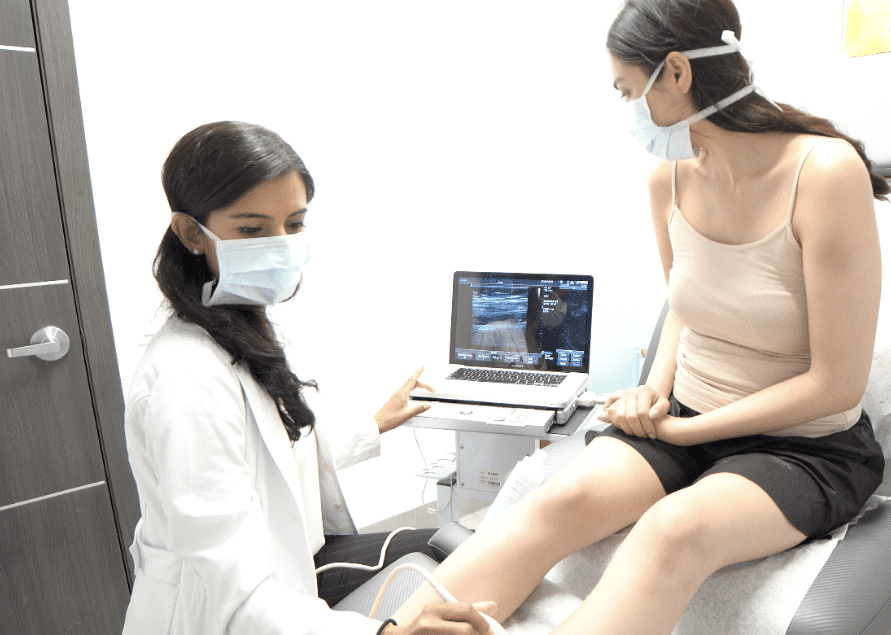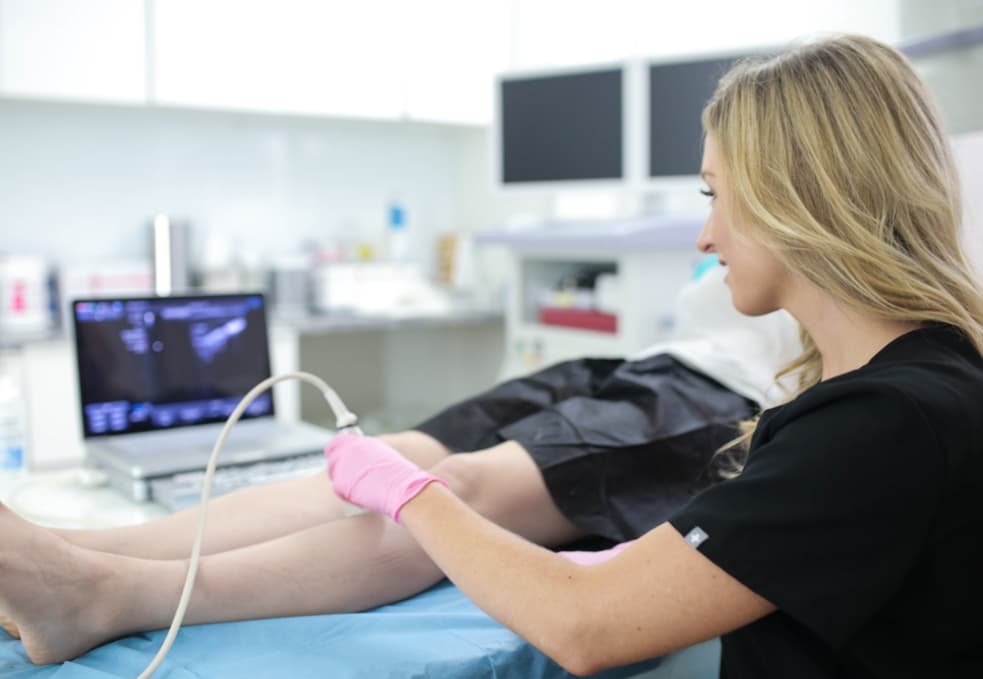What is the treatment for heaviness in the legs?
Leg heaviness, aching and heavy legs, and leg swelling are some of the most common early warning signs of vein disease, a dangerous medical condition caused by the collapse of vein valves. Leg heaviness can be caused by numerous factors, but vein disease is the likely cause if the symptoms worsen at the end of the day or after long periods of sitting or standing still.
If your heavy legs are symptomatic of chronic venous insufficiency, you must find reliable vein doctors who will diagnose and treat the underlying cause. Our vein doctors examine your leg veins, review your medical history, and administer ultrasound diagnostic scans to visualize the blood flow in leg veins, allowing them to identify and treat underlying vein disease.
The Long Island Vein Center performs a wide range of diagnostic techniques to visualize the blood flow in your leg veins and diagnose the true root cause of leg heaviness. Finally, our vein doctors recommend minimally invasive treatments that address the root cause of leg heaviness, such as endovenous laser ablation, radiofrequency ablation, venaseal, and ambulatory phlebectomy.
Minimally invasive vein treatments destroy or neutralize the diseased vein responsible for most of your vein problems, thus rerouting the accumulated blood into healthier leg veins. The treatments are in-office procedures that conclude within an hour with no downtime. If you’re experiencing heaviness in your legs, please schedule an appointment to explore your treatment options.

Understanding the root cause of leg heaviness
Leg heaviness, aching legs, and fat legs are common symptoms of numerous health conditions. Heaviness in your legs can be caused by completely benign reasons, such as the overuse of legs, or it can also be caused by underlying medical conditions, such as chronic venous insufficiency. If you have persistently heavy or aching legs, you must identify its root cause and pursue the treatment of heaviness in your legs. You may continue reading to learn about the possible causes of leg heaviness.
Overuse of Legs
Your legs might feel tired and heavy if you’ve recently used them more than usual. You should get plenty of rest, and you should increase your level of activities at a gradual pace, giving your legs enough time to acclimatize to a higher level of movement.
Underuse of Legs
Insufficient use of legs can also lead to feelings of exhaustion, aching legs, and leg heaviness. If your job involves long periods of sitting or standing still, please take frequent breaks to walk around. You can also do simple leg-raising exercises to prevent blood accumulation in leg veins.
Frequent Muscle Cramps
Overuse of legs can lead to sudden spasms or muscle cramps, which, in turn, can lead to aching legs and feelings of tiredness. You should give your legs plenty of rest after muscle cramps to minimize leg cramping sensations.
Hypokalaemia
Low levels of potassium in the body can lead to hypokalemia, which is marked by cramping sensations in the legs, weakness, and leg heaviness. Your doctor will run tests to determine if your heavy legs are truly caused by hypokalemia.
Pregnancy
You may experience leg heaviness, aching legs, and leg swelling if you’re pregnant. That’s because pregnancy increases fluid retention in your legs, and there’s increased pressure on veins, which can also lead to blood accumulation in your veins.
Multiple Sclerosis
Multiple sclerosis is a medical condition wherein the connection between your nerves and muscles is disrupted, leading to tingling and numbness, loss of balance, leg heaviness, aching legs, and numerous other symptoms.
Lipedema Disease
Lipedema disease is a common condition wherein excess fat accumulates in the lower extremities of your body. If you’re wondering, “why are my legs so fat,” you might have underlying lipedema disease.
Chronic Venous Insufficiency
Chronic venous insufficiency is one of the most underdiagnosed causes of leg heaviness, aching legs, and leg swelling. If your symptoms worsen at the end of the day or after long periods of sitting or standing, you may have underlying venous insufficiency.
Chronic venous insufficiency is one of the leading causes of persistent leg swelling and heaviness
Chronic venous insufficiency is the root cause of most vein problems, including spider veins, varicose veins, leg swelling, leg heaviness, and aching legs. If your symptoms escalate and worsen at the end of the day or after long periods of sitting or standing still, there’s a strong chance you might have underlying vein disease.
Chronic venous insufficiency is a medical condition wherein your vein valves collapse, and blood flows backward to accumulate in the leg veins. In healthy veins, the valves act as one-way doors to ensure smooth blood circulation to the heart. The collapse of vein valves leads to backward blood circulation in the leg veins, eventually leading to vascular dilation and the formation of spider veins and varicose veins.
The most common early warning signs of vein disease include leg swelling, heavy and tired legs, heavy legs, leg swelling, throbbing leg veins, leg pain, frequent leg cramps, aching legs, spider veins, and varicose veins. If left untreated, the condition worsens and eventually leads to skin discoloration, leg ulcers, and deep vein thrombosis. That’s why you must consult a reliable vein center in Long Island if you notice the symptoms of vein disease.
How to reduce swelling in feet?
If you want to reduce swelling in the feet, you must improve blood circulation in your leg veins. As mentioned previously, venous insufficiency leads to the accumulation of blood in leg veins, leading to vascular dilation, varicose veins, and leg heaviness. The best way to counter the effects of vein disease is to promote blood flow to the heart, which can be done through several lifestyle changes.
The following lifestyle changes can reduce swelling in feet:
- Wear compression stockings
- Engage in cardiovascular exercises that work your calf muscles
- Elevate your legs above the heart’s level while sitting down
- Take short walking breaks after every 30 minutes if you have a desk job
The aforementioned techniques won’t treat chronic venous insufficiency, but they’ll alleviate the symptoms of vein disease, such as leg swelling and heavy legs. The relief is temporary, so you’ll still need to contact reliable vein centers in Long Island for a diagnosis and treatment.

